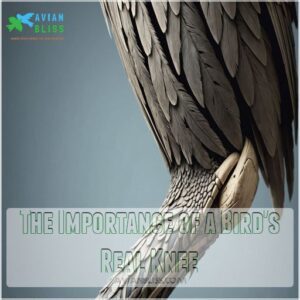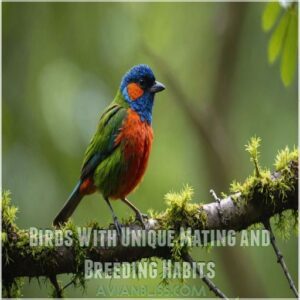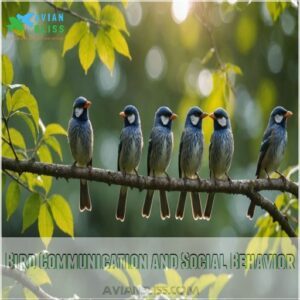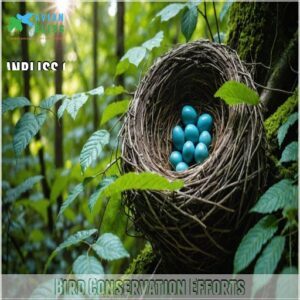This site is supported by our readers. We may earn a commission, at no cost to you, if you purchase through links.

That’s the stilt-legged flamingo for you, a star in the realm of surprising bird facts.
These flamboyant birds get their pink color from beta-carotene in their crustacean diet.
And there’s more!
The hummingbird can fly backwards, zipping around like a living helicopter, while owls are stealthy hunters thanks to their silent flight.
As for lovebirds—the literal kind—many, like swans, mate for life, highlighting their romantic side.
Curious about the most common bird?
It’s the red-billed quelea, with a staggering population size.
Stay tuned for more feathered intrigues!
Table Of Contents
- Key Takeaways
- Unique Bird Characteristics
- Bird Anatomy and Physiology
- Bird Diversity and Distribution
- Birds With Unique Mating and Breeding Habits
- Bird Migration Patterns
- Bird Communication and Social Behavior
- Birds With Unique Adaptations
- Threats to Bird Populations
- Bird Conservation Efforts
- The Significance of Birds in Human Culture
- Frequently Asked Questions (FAQs)
- What are some mysterious facts about birds?
- What are some rare facts about birds?
- What is the most mysterious bird in the world?
- What is the most unique bird in the world?
- How do birds navigate during migration?
- What predators do birds commonly face?
- How do birds stay warm in winter?
- What diets do different bird species have?
- How do birds help ecosystems thrive?
- Conclusion
Key Takeaways
- You’ll be intrigued to know that flamingos represent beauty, balance, and community, symbolizing the importance of these traits in their social behavior, as discussed in depth at flamingo symbolism. Flamingos get their pink color from the beta-carotene in their crustacean diet, and they form lifelong partnerships, reflecting their unique blend of diet and social behavior.
- Hummingbirds amaze with their ability to fly backwards and hover mid-air thanks to exceptional wing speed and unique flight patterns, showcasing their incredible adaptations for nectar feeding.
- Owls have evolved with silent flight and extraordinary head rotation capabilities, making them stealthy hunters with a fascinating blend of anatomical features.
- More than 9,500 bird species across the world exhibit diverse characteristics, from the sword-billed hummingbird to the red-billed quelea, highlighting nature’s vibrant spectrum of avian life.
Unique Bird Characteristics
Get ready to be amazed!
You’ll discover some truly bizarre and wonderful adaptations in the amazing world of birds,
from incredibly long bills to the ability to turn their heads almost completely around.
Birds With Extraordinary Features
Ever seen a bird with a bill longer than its body?
Meet the Sword-billed Hummingbird—an architectural wonder of nature!
With their extreme feather counts, birds like the whistling swan boast up to 25,000 feathers, unrivaled in the avian world.
And let’s not forget exceptional vision; owls might just spin their heads for a better view.
Amazing, right?
Hummingbirds’ Unique Abilities
Imagine a tiny bird zipping around, sipping nectar at lightning speed.
That’s the hummingbird for you!
These amazing creatures can even hover in mid-air and fly backwards, thanks to their incredible wing speed and unique flight patterns.
You can learn more about hummingbird facts and their fascinating adaptations.
Thanks to their incredible hovering flight and rapid wing speed, these feathered wonders can fly backwards and even upside-down.
Their unique tongue adaptations make nectar feeding efficient.
Explore these bird facts, and you’ll see why hummingbirds are a fascinating bird species with remarkable adaptations.
Owls’ Special Talents
While hummingbirds dazzle with their speed, owls impress with unique talents, having evolved into 50+ species, including the Elf Owl, the smallest owl in North America, often nesting in cacti, as part of their diverse characteristics types of owls.
Their silent flight makes them nighttime ninjas, with head rotation that leaves you awestruck.
Their extraordinary owl hearing pinpoints prey from afar.
Equipped with
Birds With Bright Colors
Peacocks strut their stuff with dazzling plumage, thanks to pigments and light refraction, showcasing evolution’s flair for dramatic bird coloration.
These vibrant hues aren’t just for show; they’re essential for survival.
Some bird species use bright colors as camouflage, blending into colorful environments, while others rely on mimicry to confuse predators.
It’s nature’s art show with life-or-death stakes!
Bird Anatomy and Physiology
You’ve got to admire the fascinating quirks in bird anatomy and physiology, like how their efficient lungs outpace those of mammals or how their cloaca multitasks.
And don’t get us started on the hidden knees under feathers—birds sure know how to keep secrets!
The Structure of Bird Lungs
Birds probably seem like avian superheroes with their ability to thrive at high altitudes, thanks to their lung efficiency.
Their lungs are a masterpiece of biology—air flows continuously through intricate air sacs, unlike our clunky bellows-like system.
This unique adaptation gives them incredible stamina and better oxygen exchange, perfect for long flights or quick evasions.
Bird respiration truly is next-level!
The Function of a Bird’s Cloaca
Ever wondered about a bird’s single opening?
It’s called the cloaca, and it’s a marvel of evolution!
This amazing organ handles several key functions:
- Waste removal: Think of it as a multi-purpose plumbing system.
- Reproduction: Some birds can even lay eggs without a mate due to environmental triggers and hormonal regulation. Birds use it to lay eggs and mate.
- Excretion: Urine and feces exit through this one opening.
Pretty efficient, right?
It’s a great example of bird biology’s clever design.
The Importance of a Bird’s Real Knee
Underneath a bird’s feathers lies the real knee, essential for bird locomotion and flight mechanics.
It’s like a hidden superhero cape, helping with efficient movement.
Table: Bird Knee Importance
| Aspect | Description |
|---|---|
| Evolution | Adaptation for diverse environments |
| Function | Efficient flight and ground locomotion |
| Injury Impact | Limits movement, recovery essential |
This unsung hero aids bird adaptations and behavior.
The Role of Beta-Carotene in Flamingos’ Diet
While feathers hide many wonders like birds’ knees, flamingos flaunt theirs in pink, crediting beta-carotene.
Imagine dining on crustaceans and plankton, painting your feathers!
This pink pigment isn’t just for show; it’s an adaptation for their social behavior.
Without their rosy hue, flamingos would be, well, just not as fabulous in the bird world of coloration and characteristics.
Bird Diversity and Distribution
You might be surprised to learn there are over 9,500 bird species fluttering around the globe, from lush tropical rainforests to bustling cities.
The common red-billed Quelea rules the skies with its impressive numbers, while the elegant whistling swan boasts the most feathers.
The Number of Bird Species in The World
Exploring bird species, did you ever wonder how many types flutter around our planet?
With over 9,500 bird species globally, their diverse distribution is a clear indication of nature’s artful play.
From rain forests to everyday backyards, birds showcase amazing diversity.
Some species face threats and need protection, highlighting the critical importance of bird species conservation and evolution.
The Most Common Wild Bird in The World
Think the world’s full of exotic bird species? You’re right, but the most common wild bird is the humble red-billed quelea.
This isn’t the only bird that thrives in abundance – the house sparrow, with its adaptable nature and ability to exploit human-altered environments, can be found on every continent except Antarctica.
These little guys, found all over Sub-Saharan Africa, form flocks that can
Birds Found in Tropical Rain Forests
Ditching the safety of the commonplace, imagine two-thirds of all bird species thriving in the vibrant chaos of tropical rainforests.
These biodiversity hotspots are like bustling avian cities, where canopy dwellers and understory birds flaunt their unique features and quirky behaviors.
But, with tropical bird threats looming, these colorful habitats need our attention more than ever.
The Bird With The Most Feathers
So, you’re amazed by rainforests’ birdlife? Let’s shift gears! Did you know the whistling swan boasts up to 25,000 feathers? That’s a whole lot of fluff! These feathers are essential for insulation, flight, and even courtship displays. Their function is amazing, isn’t it?
- Each feather has a specific purpose.
- Molting is a regular process for feather renewal.
- Swan feathers are incredibly lightweight yet strong.
- Feathers’ evolution is a fascinating tale of adaptation.
Birds With Unique Mating and Breeding Habits
When you explore the realm of birds, you’ll find that their unique mating and breeding habits are as fascinating as they’re varied.
From flamingos that stay together for decades to intricate nest-building rituals, these feathered friends know how to keep things interesting!
Flamingos’ Lifelong Partnerships
Flamingos aren’t just famous for their pink feathers; they also form lifelong bonds, a strong indicator of their unique character.
These birds rarely divorce, showcasing loyalty that would make any romance novel blush.
With synchronized courtship rituals and shared responsibilities in raising chicks, flamingos embody enduring love.
Here’s a glimpse:
| Aspect | Flamingos Details |
|---|---|
| Lifelong Bonds | Rarely divorce |
| Mate Selection | Synchronized rituals |
| Parental Care | Shared chick raising |
| Bird Behavior | Elegant social dance |
| Unique Features | Vivid pink plumage |
The Mating Rituals of Birds
Ever wondered about the dramatic world of bird courtship?
Imagine the peacock unfurling its stunning feathers in a mesmerizing mating dance.
Bird behavior paints quite a picture:
- Spectacular displays captivate mates.
- Synchronized dances engage partners.
- Vocal serenades echo through forests.
- Beautiful plumage showcases evolutionary wonders.
These rituals reveal bird communication, celebrate reproduction, and highlight fascinating species characteristics.
The Nesting Habits of Birds
In the realm of bird reproduction, nest building is an art form.
You might wonder why—or how—different bird species, like the long-necked birds that employ unique feeding strategies such as filter feeding techniques, craft nests with unique materials, adapting to predators and varying habitats.
Some, like the baya weaver, use grass and leaves, while others might surprise you with their skillful use of mud or even spider silk to promote their survival.
You can learn more about the diverse nesting habits of birds, including how to create the perfect environment for them, by visiting a resource for bird nesting.
Some, like the baya weaver, use grass and leaves, while others might surprise you with their skillful use of mud or even spider silk to promote their survival.
The Importance of Monogamy in Birds
While observing their intricate nests, you might wonder about birds’ committed lifestyles.
Monogamy in birds like flamingos and albatross leads to lifelong bonds, enhancing mate selection and parental care.
Some species, such as blue jays, showcase remarkable examples of birds that mate for life.
These long-term partnerships boost evolutionary benefits, ensuring chicks thrive.
Their social dynamics blend bird intelligence with practicality, showcasing unique behaviors.
Bird Migration Patterns
Ever wonder how birds know exactly where to go for vacation?
Incredibly, the Arctic Tern’s annual trip around the world would make any frequent flyer jealous, as it covers more miles than any other migrating bird.
The Longest Migration Route
Some birds are incredible travelers! You’ll be amazed by their migration distances. Think of the fuel for flight – it’s quite a feat! Navigation challenges? They face those head-on.
- Climate change impacts their journeys.
- Conservation efforts are essential for their survival.
- Bird migration is a wonder of nature.
- It’s a fascinating aspect of bird behaviors.
The Siberian Plover’s Migration
The ambition of the Siberian Plover’s migration makes you marvel at bird behaviors and their endlessly fascinating journeys.
These plucky plovers set off on one of the longest journeys, tracing a zigzag pattern from the Arctic to South Africa.
They face migration challenges like finding food sources amidst vast distances, all while raising their young.
It’s like an epic bird road trip!
The Arctic Tern’s Annual Migration
After admiring the Siberian Plover’s zigzag journey, let’s marvel at the Arctic Tern’s epic annual migration.
These small but mighty birds travel from the Arctic to Antarctica and back, logging over 44,000 miles.
Flying through ocean breezes and frigid waters, they overcome migration challenges with remarkable precision.
It’s a demonstration of their endurance and the mysteries of bird navigation worth pondering.
The Reasons Behind Bird Migration
Imagine soaring like the Arctic Tern, traveling vast distances.
Birds migrate for important reasons, searching for:
- Food availability: Heading where feasts await.
- Breeding grounds: Preparing cozy nests for new life.
- Predation avoidance: Escaping danger zones.
Fueled by instincts, these majestic migrations showcase animal adaptations, turning challenges like weather changes and seasonal shifts into opportunities for survival and new adventures.
Bird Communication and Social Behavior
When you think about how birds chat, you might picture a noisy morning chorus, but there’s much more to their communication than just songs.
Birds use a mix of vocal calls, body language, and intricate social structures to show they’re the true chatterboxes of the animal world.
The Language of Birds
Ever wonder how birds manage their epic journeys?
It’s all about their language.
Bird calls, bird sounds, and bird songs play a huge role in navigation and bonding.
You’ve got song dialects telling stories of migration, non-vocal signals enhancing communication, and even bird mimicry outsmarting predators.
It’s like a feathered secret code.
| Bird Language | Example | Purpose |
|---|---|---|
| Bird Calls | Sparrows | Alert |
| Bird Songs | Robins | Mating |
| Mimicry | Mockingbirds | Camouflage |
| Non-vocal Signals | Pigeons | Direction |
| Song Dialects | Finches | Identity |
The Social Structure of Flocks
In the enchanting world of birds, social behavior shines as a marvel.
Flock hierarchy isn’t just a pecking order; it’s a dynamic network.
Through complex communication methods, birds manage group defense, foraging strategies, and even migration coordination.
These interactions reveal fascinating bird traits and habitats, showcasing unique features that help species thrive together amidst challenges and opportunities.
The Importance of Song in Birds
A bird’s song? It’s way more than just a pretty tune!
You’ll find it’s key for bird communication, essential for attracting mates (mating calls!), and even helps defend territory.
Different bird species have unique songs, making species identification a breeze. Think of it as their personal ID card and a way to show off their amazing vocal talents!
Song evolution has shaped these beautiful melodies over millions of years. Pretty cool, huh?
The Role of Body Language in Birds
Songs enchant the air, but birds also chat through body language.
Whether strutting feathered stuff in courtship displays or sending threat signals, they’re masters of nonverbal cues.
Imagine this: sparrows in flock communication or hawks in nest defense.
Their gestures even settle food competition debates!
With their expressive moves, bird social behavior uncannily mirrors human body language dynamics.
- Flock communication
- Threat signals
- Nest defense
Birds With Unique Adaptations
Ever wonder how birds like woodpeckers and penguins thrive in their unique environments?
You’ll discover how woodpeckers have specially adapted to hammer away without headaches,
and how penguins‘ feathers double as sleek wetsuits for icy waters.
The Woodpecker’s Adaptation to Its Environment
Woodpeckers are nature’s drummers, didn’t you know?
Their beaks are perfectly adapted for chiseling into tree bark, searching for tasty insects to snack on.
It’s wild how their tongues can reach deep crevices, revealing more about bird evolution.
The design of their nesting cavities is genius, reducing the competition in forests — a fascinating example of wildlife adaptation.
| Adaptation | Function | Fun Fact |
|---|---|---|
| Beak | Drumming behavior | Acts like a chisel |
| Tongue | Insect hunting | Can be 4 inches long! |
| Skull structure | Head protection | Prevents brain injury |
| Nest cavity design | Secure nesting area | Made to deter rivals |
The Hummingbird’s Ability to Fly Backwards
Ever wonder how hummingbirds zip around so effortlessly?
Their unique ability to fly backwards is a marvel of evolution.
With wings flapping at immense speeds, they hover like little helicopters, sipping nectar with precision.
It’s all about their incredible wing structure and rapid bird flight mechanics.
Hummingbirds exhibit behaviors similar to the birds that engage in cloacal kiss mating, truly demonstrating some of the most fascinating bird unique features in the avian world!
The Ostrich’s Powerful Legs
Imagine you’re spotting ostriches in the wild, marveling at their powerful legs.
These flightless birds aren’t just about speed; they turn heads with their remarkable adaptations.
Consider these standouts:
- Running Speed: They hit up to 45 mph!
- Kick Strength: Powerful enough to deter predators.
- Bone Structure: Legs built like shock absorbers.
Their survival secrets are fascinating!
The Penguin’s Unique Feathers
Just as ostriches stride with powerful legs, penguins boast feathers unlike any other bird species.
These feathers are brilliant penguin adaptations, offering waterproofing essential for frigid waters.
They’re layered for maximum insulation, keeping penguins cozy in icy habitats.
Remarkably, during the breeding season, these bird characteristics highlight penguin evolution’s fascinating path, showing how bird feathers can be highly specialized, aiding survival in extreme conditions.
Threats to Bird Populations
Sadly, many bird populations face serious threats. Habitat loss, climate change, and invasive species are just some of the challenges these amazing creatures are battling, impacting their survival.
The Impact of Human Activities on Birds
Spotting a bird in its natural habitat can feel like finding treasure.
But human activities, like habitat loss and pollution impact, are threatening these winged wonders.
Overhunting and the bird trade make survival tricky.
With bird species characteristics being so diverse, it’s essential to promote bird conservation, preventing extinction before these beautiful creatures vanish into tales of yesteryears.
The Effects of Climate Change on Birds
Human activities play a role, yet climate change really stirs the pot for bird species.
Picture adrift migrations as temperatures sway, leaving food scarce and breeding routines upside down.
Birds, feeling the heat, also face disease spread, putting entire species on the edge.
Climate shifts reshape bird habitats, throwing nature’s winged travelers into a carousel of unforeseen changes.
The Role of Habitat Destruction in Bird Extinction
Imagine a forest—or rather, what’s left after deforestation and climate change have wreaked havoc on bird habitats.
Habitat destruction is a major villain in the saga of bird extinction, pushing many bird species to the brink.
Pollution and over-hunting only add fuel to the fire.
Ecotourism offers a glimmer of hope but requires our active participation to conserve precious habitats.
The Threat of Invasive Species to Birds
Just when you thought habitat destruction was the last straw, there’s more.
Invasive species are birds’ silent competition, sneaking in and causing habitat disruption.
They’re like uninvited guests at a party, edging out native species.
In fact, they can also introduce pests that spread vector-borne diseases, further threatening bird populations.
This leads to species decline and even bird extinction.
Conservation efforts
Bird Conservation Efforts
You’ll be amazed to learn how protecting bird habitats can be both a monumental task and an incredibly rewarding endeavor.
As communities come together in wildlife reserves, these conservation efforts show promise in boosting bird populations, proving that teamwork truly makes the dream work for our feathered friends.
The Importance of Protecting Bird Habitats
While habitat loss knocks on birds’ doors, protecting these avian sanctuaries becomes a top priority.
Bird conservation isn’t just for the birds; it’s for you too!
Think about it—safeguarding bird habitats helps fend off climate change and supports biodiversity.
So, next time you’re out birdwatching, know your appreciation fuels sustainable practices aimed at preserving these magnificent migrants.
The Role of Wildlife Reserves in Conservation
Protecting bird habitats is a big deal, right?
Wildlife reserves are key to this.
They’re havens where birds can thrive, free from many threats.
Think of it like this:
- Safe nesting sites.
- Plentiful food sources.
- Reduced human disturbance.
- Habitat restoration projects.
These reserves aren’t just about saving endangered species; they’re also great for ecotourism, bringing in money for reserve management and boosting local economies.
It’s a win-win for birds and people!
The Impact of Conservation Efforts on Bird Populations
Picture vibrant habitats brimming with birdsong, thanks to conservation efforts.
Supporting these initiatives is made easier with online platforms like Bird Conservation Success, conservation efforts products.
These success stories showcase incredible species recovery, like the majestic California Condor, once on the brink.
Population trends now flutter upwards, though challenges persist, like threats from habitat loss and climate change.
Amid
The Importance of Community Involvement in Conservation
Imagine a world where bird conservation is a community effort.
You can join citizen science projects or birdwatching groups to make a difference.
Here’s how you can help:
- Volunteer efforts: Spend time in local initiatives to protect habitats.
- Community education: Teach others bird trivia and species classification.
- The unique beaks of birds like toucans, which have serrated beaks for crushing fruits, play a vital role in their feeding techniques and adaptations. Engage in discussions: Share fascinating bird migrations and beak facts.
The Significance of Birds in Human Culture
While ensuring birds have secure habitats is a hot topic, their cultural role is just as fascinating.
From ancient myths to modern music, birds have soared through human imagination, capturing hearts and minds.
Think of wise owls whispering wisdom in mythology or doves symbolizing peace.
A bird flying into your home can be a sign of good luck and new beginnings, as seen
Frequently Asked Questions (FAQs)
What are some mysterious facts about birds?
Birds never cease to amaze.
Did you know a woodpecker’s tongue is so long it wraps around its brain?
Or that flamingos pair for life and owe their pink color to their shrimp-heavy diet?
What are some rare facts about birds?
Did you know a hummingbird’s bill’s longer than its body? Or that owls can’t move their eyes, but their heads rotate? These are just a couple of amazing bird facts!
What is the most mysterious bird in the world?
Picture a bird that’s a rock star of the avian world, the kakapo.
This nocturnal parrot from New Zealand is shrouded in mystery.
It’s critically endangered, can’t fly, and has a booming, echoing call.
What is the most unique bird in the world?
You might find the Kakapo, a flightless parrot from New Zealand, incredibly unique.
The Kakapo is the heaviest parrot, but it’s also nocturnal and has a charming, owl-like face.
Talk about a quirky bird!
How do birds navigate during migration?
Birds navigate using a mix of sun, stars, Earth’s magnetic field, and landmarks.
It’s like they’ve GPS built-in!
They can even sense magnetic fields, helping them find their way over vast distances during migration.
What predators do birds commonly face?
Imagine the sky, a stage where hawks, cats, and even snakes lurk as the unexpected villains.
Birds face these predators daily, weaving between danger and survival, like a high-stakes game of hide-and-seek in nature’s playground.
How do birds stay warm in winter?
Think of a bird’s winter survival strategy, which often includes a state of torpor to conserve energy, similar to true bird hibernation. Think of a bird’s winter survival kit as a feathered coat and a buffet line.
Birds fluff their feathers to trap air for extra warmth and snack frequently to maintain energy.
They’re like nature’s little survival experts!
What diets do different bird species have?
You’ve got tiny hummingbirds sipping sugary nectar, while eagles feast on meatier prey.
Parrots munch on seeds, and flamingos love a shrimp platter for that lovely pink glow.
Birds’ diets vary as much as their colorful feathers!
How do birds help ecosystems thrive?
Like tiny ecosystem engineers, birds spread seeds, pollinate plants, and control insect populations. You’ll find they’re essential for a healthy planet, a vibrant web of life!
Conclusion
From flamingos flaunting fabulous features to hummingbirds’ mesmerizing maneuvers, the bird world never ceases to amaze.
Delving into these surprising bird facts, you discover how diverse, adaptable, and downright fascinating our feathered friends are.
Whether it’s their vivid plumage, unique mating dances, or impressive migrations, each species offers a window into the wonders of the natural world.
So next time you spot a bird, take a moment to appreciate the incredible stories they silently tell.
















